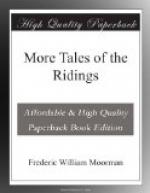Years passed away and a gradual change came over the character of the social and economic life of Holmton. The town became linked up by rail with Leeds and Bradford, and in this way it lost its isolation and caught an echo of the ideas and views of life of the people in the big towns. Elementary education was introduced, and the printed book slowly found its way into the weavers’ cottages. Most important change of all, the hand-loom gave place to the power-loom. Factories were built by the side of the beck, and while a certain amount of weaving continued to be done by the old people in their cottages, the younger generation sought employment in the mills, and payment for piecework gave way to time-wages. Most of the younger weavers welcomed this change when it was fully understood. They found that the hours of work, though still terribly long, were shorter than those spent by their parents over their hand-looms, and the social intercourse of the mill, where the youths and girls met their equals in age, was deemed preferable to the family labours in the upper story of the cottages. Moreover, if the overseers and foremen in the mills were often brutal, the workers could, at any rate, get away from the atmosphere of the weaving-shed when the hooters sounded at six o’clock in the evening.
When this revolution in industrial life took place Tom Parfitt found himself too old to adapt himself to the change.
“T’ hand-loom’s gooid enough for me,” were his words. “If I went to work i’ t’ mill I’d feel like givin’ up an owd friend, just because he’d grown owd-feshioned. I’ll stick to cottage wark, choose-what other fowks may do.”
Hearing this decision, his wife at once decided to remain with him; but the three children of Parfitt’s former marriage, the youngest of whom was now seventeen, determined to seek work in the factories. The family was thus split up, and the younger generation brought back into the house at night new ideas gained amid the social intercourse of the mill.
Mary Whittaker’s position in the town after her marriage to Parfitt was quietly accepted by the community of weavers. They still called her by her maiden name, but there was nothing unusual in that. Often, too, she was referred to as “Mary that was selled for sixpence,” but here again, at least as far as the older generation was concerned, no stigma was implied. It was simply a frank statement of fact. With the younger generation, however, who were quicker than their elders in absorbing new ideas and new codes of social convention, “Mary that was selled for sixpence” was a name that aroused curiosity, and sometimes derision. Occasionally Mary’s stepdaughters would be twitted about the name at the mill, and their faces would burn as they realised that a dark shadow hung over the woman whom they had been taught to call mother, and who had won their hearts from the day on which she first set foot in their father’s house. Once they spoke of the matter to their father, anxious to learn the exact truth from his lips.




